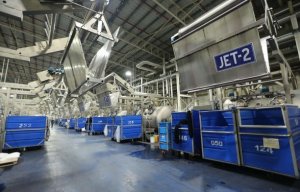
Gildan supports FireAid concert relief
The company’s first quarter performance was largely in line with its expectations.

3rd May 2018
Knitting Industry
|
Montreal
Excluding the impact of after-tax restructuring and acquisition-related costs of US$ 6.7 million in the quarter and US$ 6.6 million in the prior year quarter, Gildan reported adjusted net earnings of US$ 74.6 million, down from US$ 90.1 million in the same quarter last year. The 12.8% decrease in adjusted diluted EPS in the quarter was mainly driven by lower gross profit and higher SG&A expenses, partly offset by lower income tax expense and the benefit of a lower share count compared to the prior year.
The company’s first quarter performance was largely in line with its expectations. Consistent with the company’s guidance initiated in February 2018, adjusted EPS was down in the quarter compared to the record level achieved in the first quarter last year. The company continued to see strong sales momentum in higher growth product areas such as fashion basics, as well as strong double-digit sales growth in international markets, although as anticipated, temporary product availability constraints limited the company’s ability to fully capitalise on sales demand in the quarter.
Net sales of US$ 647.3 million in the first quarter were down 2.7%, compared to the prior year reflecting a 3.2% increase in activewear sales and a 20.4% decline in the hosiery and underwear category. The increase in activewear sales was mainly due to higher net selling prices, including foreign exchange and favourable product-mix driven by double digit sales growth in the fashion basics category, including American Apparel, Comfort Colors, and Gildan Softstyle ring-spun offering.
International sales in the first quarter were up 24%, reflecting strong growth momentum in all markets. The decline in the hosiery and underwear sales category was mainly due to the anticipated decline in unit sales volumes of socks at mass retailers which are shifting emphasis toward their own private label brands. In addition, lower sock sales reflected the impact of the non-recurrence of the initial roll-out of a licensed programme to a large national chain retailer, which occurred in the first quarter of the prior year. Underwear point of sales (POS) continued to perform strongly in the quarter.
Gross margin in the first quarter of 2018 totalled 27.2%, reflecting a 120-basis point decrease over the same period last year. SG&A expenses for the first quarter of 2018 amounted to US$ 93.1 million, or 14.4% of sales, compared to US$ 89.2 million, or 13.4% of sales, in the first quarter of 2017.
For the first quarter of 2018, the company generated operating income of US$ 76.3 million and adjusted operating income of US$ 82.7 million, down 18.0% and 17.0%, respectively, compared to the same period last year. Adjusted operating margin for the first quarter was 12.8% compared to 15.0% in the first quarter of 2017.
The company consumed US$ 40.0 million of free cash flow in the first quarter 2018 compared to free cash flow generation of US$ 41.3 million in the same quarter last year. Capital expenditures of US$ 22.4 million in the quarter were primarily for investments in textile capacity expansion, distribution, information technology, and sewing capacity. The company ended the first quarter of 2018 with net debt of US$ 723.5 million.
The company reaffirmed its full year 2018 financial guidance of adjusted diluted EPS in the range of US$ 1.80 to US$ 1.90 on projected net sales growth in the low to mid-single-digit range, adjusted EBITDA in the range of US$ 595 to US$ 620 million, and projected free cash flow of around US$ 400 million for the year.
Projected growth in adjusted diluted EPS for 2018 continues to reflect the projected impact of higher sales, anticipated cost reductions related to efficiency gains expected from the streamlining of the company's sales and marketing infrastructure in connection with its organizational consolidation, and the benefit of a lower share count compared to the prior year. These positive factors are projected to be partly offset by higher raw material and other input costs, expenses related to e-commerce and distribution initiatives to support direct-to-consumer fulfilment capabilities, and slightly higher income tax expense.

Business intelligence for the fibre, textiles and apparel industries: technologies, innovations, markets, investments, trade policy, sourcing, strategy...
Find out more